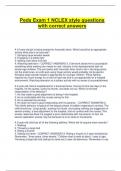Peds Exam 1 NCLEX style questions
with correct answers
A 10-year-old girl is being treated for rheumatic fever. Which would be an appropriate
activity while she is on bed rest?
1. Stringing large wooden beads
2. Engaging in a pillow fight
3. Making craft items from felt
4. Watching television - CORRECT ANSWERS-3. Craft work allows her to accomplish
something while meeting her needs for rest. Industry is the developmental task for
school-age children. The joint pains with rheumatic fever tend to be in the large joints,
not the small ones, so craft work using finger activity would probably not be painful.
Stringing large wooden beads is appropriate for younger children. Pillow fighting
requires too much energy for a child on bed rest and is not appropriate for a hospital
environment. Watching television is a solitary activity with no sense of accomplishment
A 2-year-old child is hospitalized for a fractured femur. During his first two days in the
hospital, he lies quietly, sucks his thumb, and does not cry. Which is the best
interpretation of his behavior?
1. He has made a good adjustment to being in the hospital.
2. He is comfortable with the nurses caring for him.
3. He is experiencing anxiety.
4. He does not have a good relationship with his parents. - CORRECT ANSWERS-3.
The child's behavior is typical of the despair phase of toddler responses to anxiety. The
child should cry. Lying quietly, sucking his thumb, and saying nothing are suggestive of
severe anxiety, a bad adjustment to the hospital, and no comfort with the nurses. This
anxiety response does not suggest a poor relationship with his parents. In fact, his
severe separation anxiety may be because he is so close to his parents.
A 3-year-old child has all of the following abilities. Which did he acquire most recently?
1. Walking
2. Throwing a large ball
3. Riding a tricycle
4. Stating his name - CORRECT ANSWERS-3. Riding a tricycle is 3-year-old behavior.
Remember, "three years, three wheels." Children start to walk at about 1 year of age.
Throwing a large ball and stating his name are 2-year-old behaviors. Remember to use
, developmental trends when determining the most recently acquired behavior—head to
tail and simple to complex. Look for a complex lower body behavior.
A 5-year-old child had major surgery several days ago and is allowed to be up. When
planning diversional activity, which action by the nurse is most appropriate?
1. Give the child a book to read.
2. Play a board game with the child.
3. Encourage the child to play house with other children.
4. Turn on the television so the child can watch cartoons - CORRECT ANSWERS-3.
Five-year-old children like cooperative play, such as playing house. The other activities
are solitary activities. Note that the child is several days postsurgery. Most 5-year-olds
are not able to read a book by themselves. Playing a board game with a child is not
wrong, but it is a solitary activity. Most 5-year-olds would prefer to play with other
children. There is almost always a better alternative than turning on the television. This
child is several days postsurgery and is able to be up and play with others.
A child has just been admitted to the facility and is displaying fear related to separation
from his parents, the room being too dark, being hurt while in the hospital, and having
many different staff members come into the room. Based on the nurse's knowledge of
growth and development, the child is likely:
1. 7 to 12 months old (an infant).
2. 1 to 3 years old (a toddler).
3. 6 to 12 years old (a school-age child).
4. 12 to 18 years old (an adolescent - CORRECT ANSWERS-2. 1 to 3 years old (a
toddler).
RATIONALE: Toddlers show fear of separation from their parents, the dark, loud or
sudden noises, injury, strangers, certain persons, certain situations, animals, large
objects or machines, and change in environment. Infants show fear of strangers, the
sudden appearance of unexpected and looming objects (including people), animals, and
heights. School-age children show fear of supernatural beings, injury, storms, the dark,
staying alone, separation from parents, things seen on television and in the movies,
injury, tests and failure in school, consequences related to unattractive physical
appearance, and death. Adolescents show fear of inept social performance, social
isolation, sexuality, drugs, war, divorce, crowds, gossip, public speaking, plane and car
crashes, and death.
A child, age 3, is admitted to the pediatric unit with dehydration after 2 days of nausea
and vomiting. The mother tells the nurse that her child's illness "is all my fault." How
should the nurse respond?
1. "Maybe next time you'll bring the child in sooner."
2. "Tell me why you think this is your fault."
3. "Try not to cry in front of the child. It'll only upset her."




